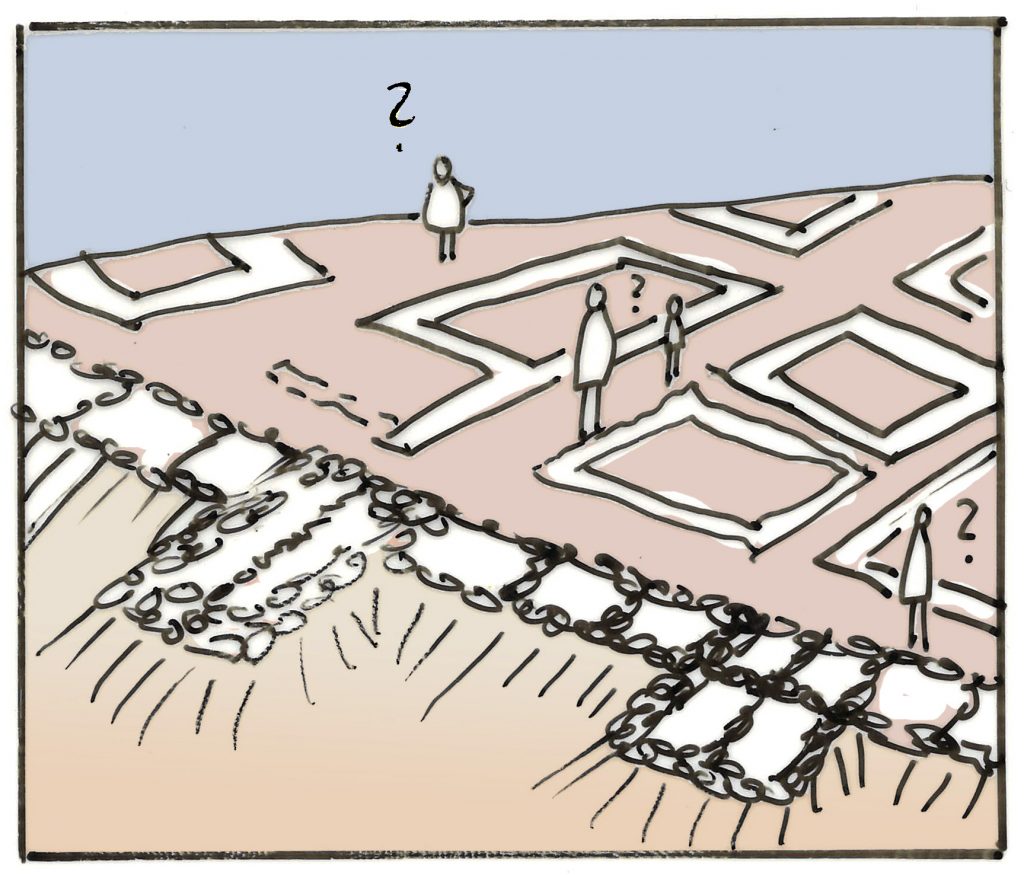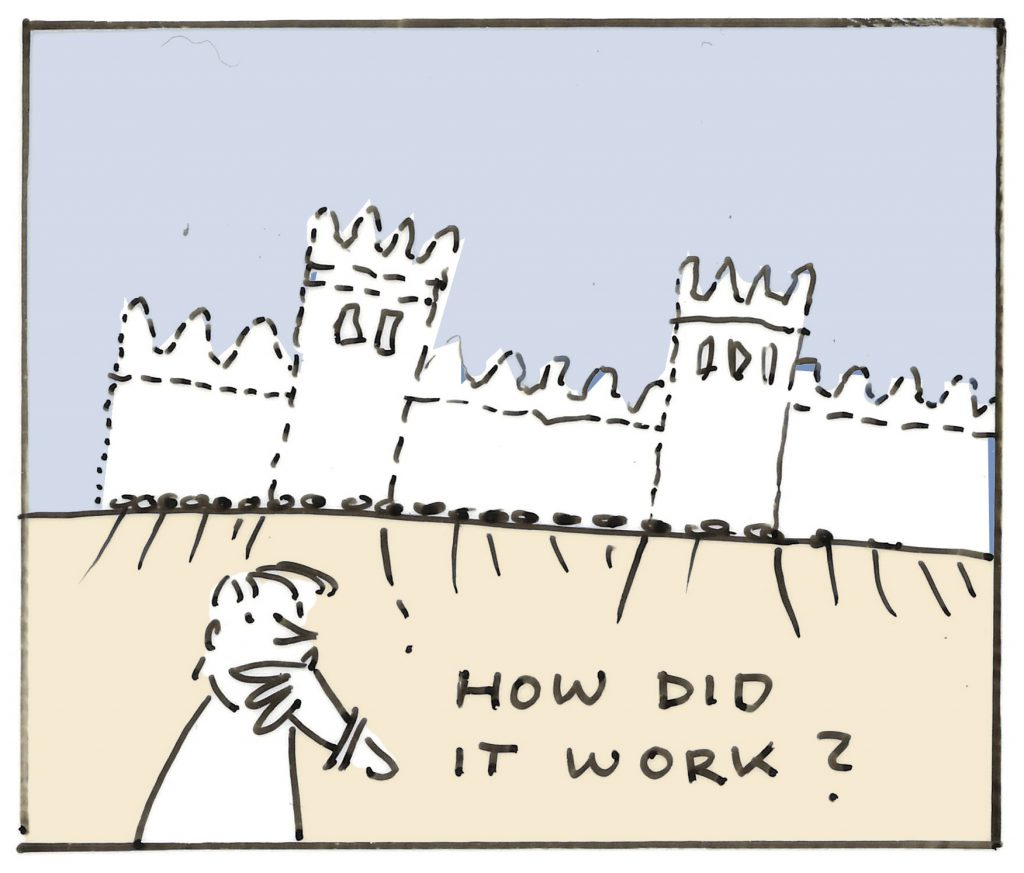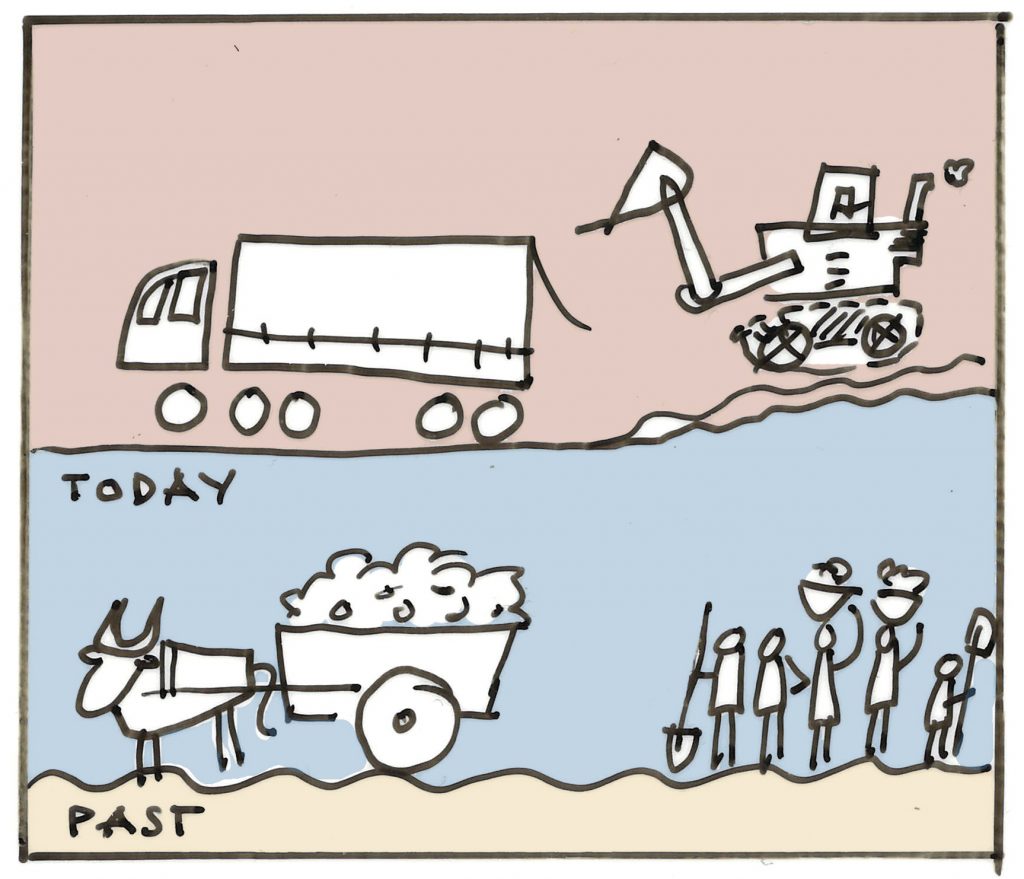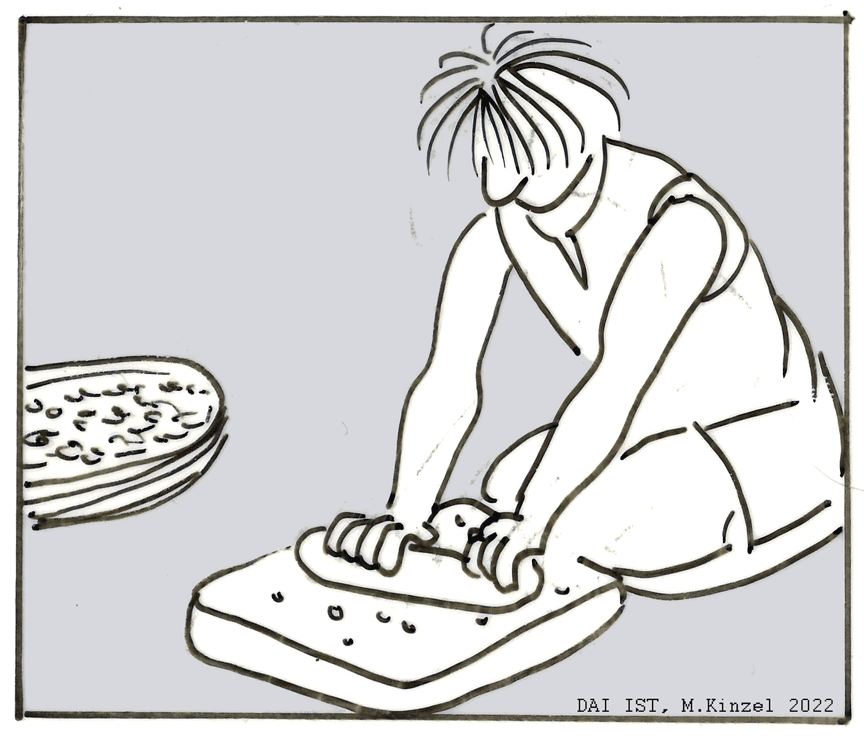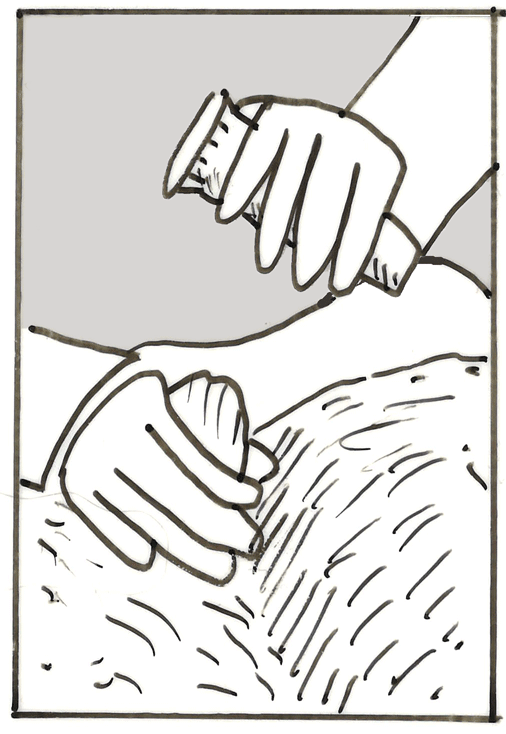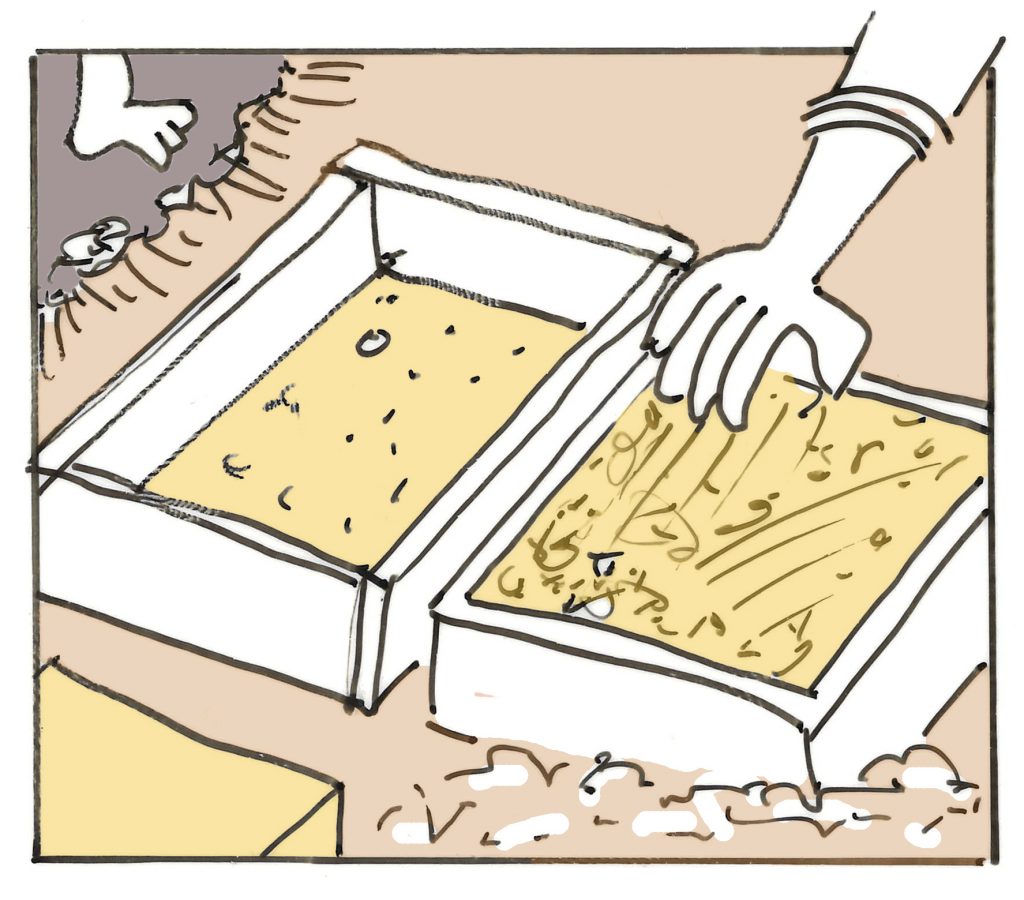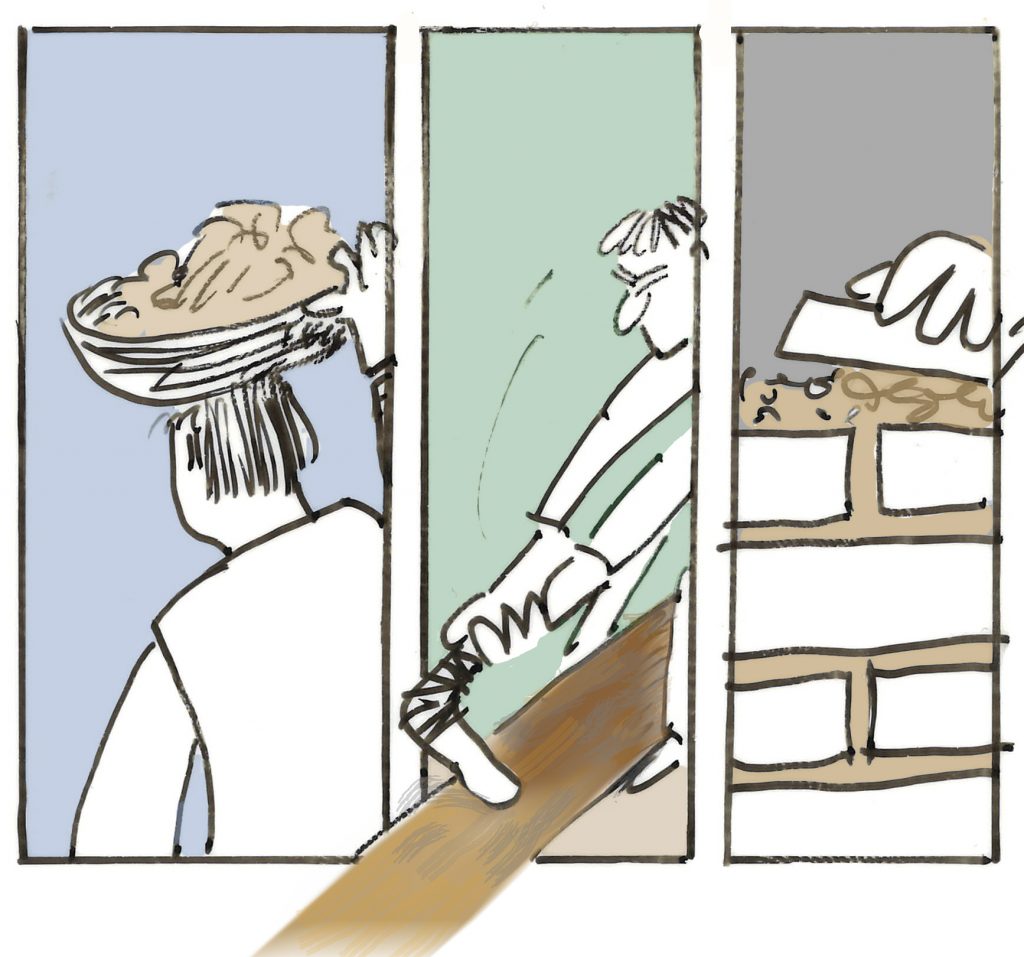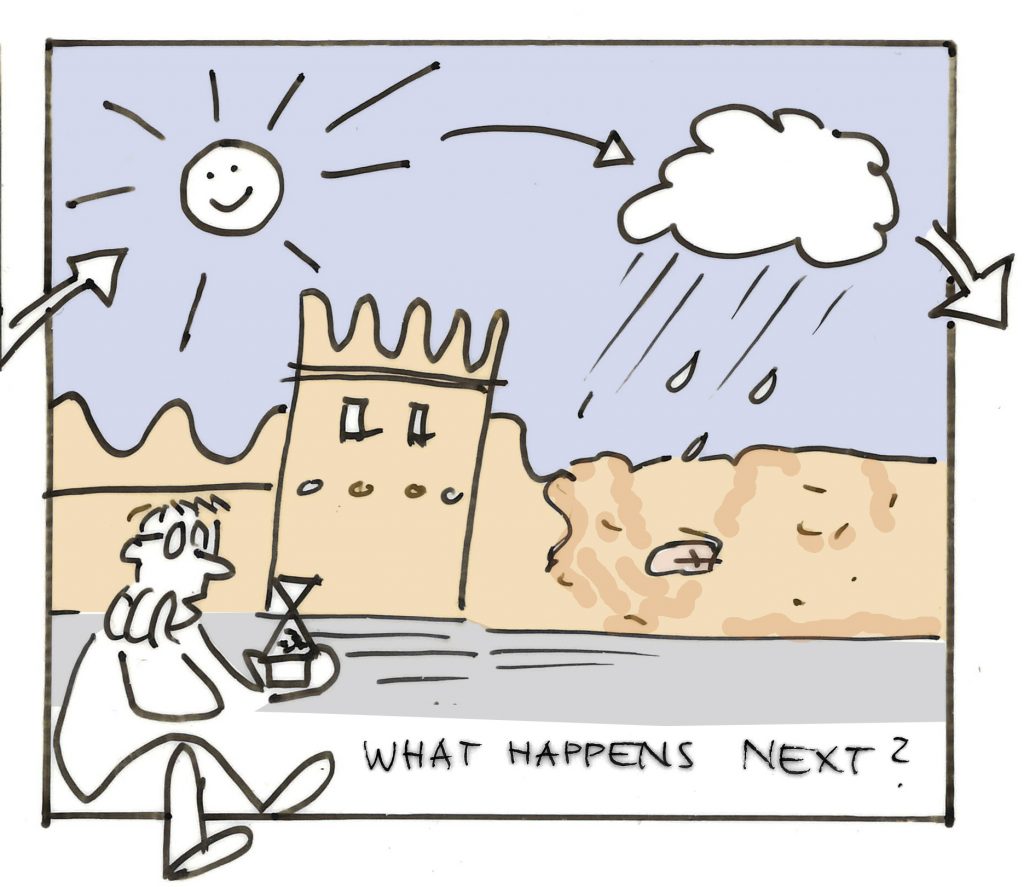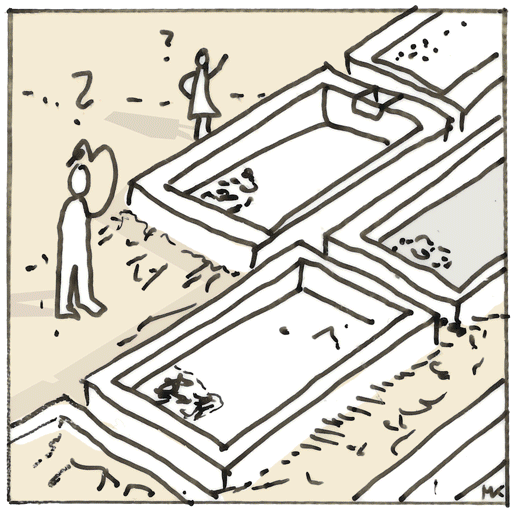What is the job of an archaeologist? Generally speaking: The archaeologist reconstructs the past of mankind and researches cultural development. And to be more precise: During excavations, archaeologists uncover the material legacies of past times and interpret them.
We people of the 21st century do not have the best qualifications for this: We’re past the industrial revolution and have entered the digital age. Most of us don’t produce anything anymore. When we need something to eat, we go to the grocery store, we buy clothes in a fashion store, and we find tools in a hardware store. Or we just order everything on the Internet. In fact, our grandparents still had a much more precise idea than we do of how the things we need to live come into being. But the production of raw materials and objects is increasingly being taken over by machines and artificial intelligence. A person today knows less and less about how plants, animals, or other natural raw materials can be used to produce food, clothing, devices of all kinds, and other objects.
As an archaeologist, how can we supplement the knowledge and personal experience that we lack to reconstruct ancient ways of life? Written sources, including those of the Middle Ages or the Greek/Roman period, give a great deal of information. However, it becomes more and more difficult the further back in time we go. There are no written sources from prehistoric times, and fewer remains are preserved while we are moving further and further away from the world we know. Ethnography is an important source of information, because here living conditions and working methods of less advanced cultures without writing are documented. Many things found during excavations can be explained by such comparisons. At least in theory.
In addition, practical experiments are a very useful tool, which is used especially in prehistoric research: How to grind flour from grain with hand millstones? How can you make functional tools from flint? What does it take to make bronze using copper ore? How to spin wool? To name just a few examples of informative experiments. The quick production of a small bead from bone can be done as an experiment, and so can the construction of a Roman warship, which takes many months. Experimental Archaeology is a research strategy for the visualization and also rediscovery of techniques, processes, objects, structures or environmental contexts through reconstruction. It is a kind of learning by doing, and often an eye-opener as well. For the scientist, the collection of data is the most important result of such an experiment. Many parameters like how much work was put in, what materials and how much of them were used, which problems arose, what remains at the end etc. can be documented and shared with the scientific community.
But experiments in archaeology have even more potential if they are carried out not only in the laboratory, but in public. This is increasingly happening in museums and especially in archaeological open-air museums, which are getting more and more popular in Europe. Here, visitors can experience the past directly, and this is often combined with a WOW factor: Is it hard to cut down a tree with a stone axe? How well do flint tools cut? How did people live in Neolithic houses? How many people are actually needed to move huge blocks of stone? While for the archaeologist it is primarily a tool for reconstructing work processes and effort, for the visitor it becomes an experience. Ideally, the visitor is not only a spectator, but also a participant who gets a glimpse of a different living environment and can put himself in someone elses place: “What would it be like if I were to live in the distant past?” Experimental archaeology becomes experiental archaeology.
Many experiments are not very complex and yield results quickly. However, there are also long-term experiments. These include, above all, the reconstructions of buildings that can be seen in many open-air museums and at an increasing number of archaeological excavation sites. Especially at prehistoric sites, because here mostly perishable materials such as wood, mud brick and wattle, and daub were used as building materials. Accordingly, the remains of such buildings found in excavations are poorly preserved and often hardly visible. Here a graphic reconstruction is certainly helpful, but it cannot replace the experience of the third dimension of a real building in its landscape.
Such a project has also been carried out at an excavation site of the German Archaeological Institute in Turkey. In Hattusa, the capital of the Hittite Empire in Central Anatolia (c.1650-1200 BC), a section of the city wall has been reconstructed. The city walls of Ḫattuša, about 9 km long in total, were built of unbaked mud bricks, as were almost all Hittite buildings. Such walls have weathered and withered away over the centuries. Today, only the foundations of rubble stones show where buildings once stood and what size they were. In fact, we know little about the appearance of the walls and the roofs. With one exception: there are models of city walls with towers, which show many building details and thus allow a reasonably reliable reconstruction.
On this basis, a 65 m long stretch of the city wall was reconstructed in 2003-2005. This alone required 2700 tons of loamy earth for mud bricks, which gives an impression of the dimension of the project in particular and the material requirements of Hittite buildings in general. A great deal of data and experience was gathered on building with mud brick, as well as on the organization of work and the procurement of raw materials.
Since the end of the construction work, the project is now in a second phase. Here, we are observing how such a large building changes over the years. To what extent do the weather, rain and snow have an effect and what effort is required for maintenance. This provides a basis for considering how great the effort must have been to maintain and preserve the many kilometers of Hittite city wall, as well as other structures.
This reconstruction project is only one of several that have been carried out in Turkey in the meantime. Here in Hattusa, the visitor sees a monumental city wall, protection, and representation of imperial power 3500 years ago. At other excavation sites, such as Aşağı Pınar (Kırklareli), Aşıklı Höyük (Aksaray) and Aktopraklık (Bursa), Neolithic dwellings have been reconstructed. Visitors can enter the buildings and thus gain an insight into even significantly earlier living environments.
Experimental archaeology thus builds a bridge between science and the visitor. It is to be hoped that real archaeological open-air museums will soon be established in Turkey as well, where visitors can also participate in archaeological experiments and get hands-on experience of some tasks our ancestors had to cope with. And get an idea of how they often balanced a minimum of equipment with a maximum of knowledge, concentration, and intuition, whereas today a minimum of knowledge and concentration is often balanced by a maximum of technical effort. A lesson in humility and WOW factor at the same time.
Jürgen Seeher, DAI Istanbul
Further Reading and Downloads
General:
- Experimental Archaeology https://exarc.net/experimental-archaeology
- Petersson, B. – Narmo, L.E., Experimental Archaeology, Between Enlightenment and Experience, Acta Archaeologica Lundensia vol. 62, Lund 2011. https://www.academia.edu/24852275/Experimental_Archaeology_Between_Enlightenment_and_Experience?auto=download
- Reeves Flores, J. – Paardekooper, R.P. (eds), 2014. Experiments Past. Histories of Experimental Archaeology, Leiden 2014. https://www.sidestone.com/books/experiments-past
Projects in Turkey:
- Duru, G. Deneysel Arkeoloji Yoluyla Neolitik Bir Ev Yapımı, Colloquium Anatolicum XIII, 2014, 131-151 https://dergipark.org.tr/tr/pub/collan/issue/61597/919785
- Eres, Z. 2014 “Kırklareli Aşağı Pınar ve Kanlıgeçit Kazılarının 20. Yılında Koruma ve Alan Yönetimi Çalışmaları – Conservation and Site Management Studies in the 20th Year of the Kırklareli Aşağı Pınar and Kanlıgeçit Excavations”, M. Bachmann, Ç. Maner, S. Tezer and D. Göçmen (eds.), Heritage in Context, Miras 2: 89-130. Deutsches Archäologisches Institut Istanbul, Ege Yayınları, İstanbul https://www.academia.edu/11319453/Conservation_and_Site_Management_Studies_in_the_20th_Year_of_the_K%C4%B1rklareli_A%C5%9Fa%C4%9F%C4%B1_P%C4%B1nar_and_Kanl%C4%B1ge%C3%A7it_Excavations
- Karul, N., Aktopraklık Açıkhava Müzesi ve Arkeoloji Okulu, Arkeoloji ve Sanat 150: EYLÜL-ARALIK 2015, XII-XXII https://www.academia.edu/29664902/Aktoprakl%C4%B1k_A%C3%A7%C4%B1khava_M%C3%BCzesi_ve_Arkeoloji_Okulu_2015
- Keskin, Y. – Tanaç-Zeren, M., Arkeolojik Alanlarda Bir Sunum Yöntemi Olarak “Arkeoparklar”, Süleyman Demirel Üniversitesi Mimarlık Bilimleri ve Uygulamaları Dergisi Araştırma makalesi MBUD 2018, 3(2):110-124 https://doi.org/10.30785/mbud.439805
- Seeher, J., A Mudbrick City Wall at Hattusa. Diary of a Reconstruction / Die Lehmziegel-Stadtmauer von Hattusa. Bericht über eine Rekonstruktion / Hattusa Kerpiç Kent Suru. Bir Rekonstrüksiyon Çalışması (Ege Yayınları, Istanbul 2007) https://www.dainst.org/projekt/-/project-display/48303
- Takaoğlu, T., Ethnoarchaeology in Turkey: a historical approach, in: Ethnoarchaeological Investigations in Rural Anatolia Volume, I (2004) https://www.academia.edu/714613/Ethnoarchaeology_in_Turkey_A_Historical_Approach_2004
